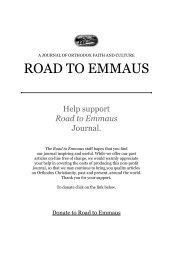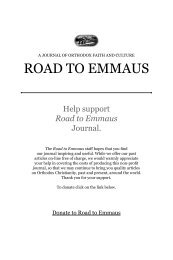RTE No 20 Interior - Road to Emmaus Journal
RTE No 20 Interior - Road to Emmaus Journal
RTE No 20 Interior - Road to Emmaus Journal
Create successful ePaper yourself
Turn your PDF publications into a flip-book with our unique Google optimized e-Paper software.
<strong>Road</strong> <strong>to</strong> <strong>Emmaus</strong> Vol. X, <strong>No</strong>. 1 (#36)and that the logical contradiction between that and God’s infinite love is notfor us <strong>to</strong> question and understand. So, the God of love becomes, in theirtheology, a tyrannical and arbitrary monster, whose excesses are far worsethan the worst tyrants of human his<strong>to</strong>ry, who only <strong>to</strong>rmented people for alimited period of time. The God of Calvinism creates some people in orderthat they should suffer for eternity.rte: And this not only severs any notion of free will, but I imagine that youwould have <strong>to</strong> take care <strong>to</strong> appear “good” <strong>to</strong> prove that you are one of thesaved, or is that <strong>to</strong>o simplistic?fr. deiniol: <strong>No</strong>, that’s very accurate. “How do we know who is saved?”“Oh, by their fruits you shall know them.” Accordingly, observable behaviorbecomes very important, and at a certain stage in the evolution of things,when conviction and faith are no longer so strongly present, this preoccupationwith appearances becomes a very distinctive characteristic of thesesocieties. That is certainly what I think happened in Wales. Also it meansthat people don’t look at the darker side of themselves, and don’t encountertheir shadow. Darkness is then projected on<strong>to</strong> other people, so you havegroups that are the scapegoats, the lowest of the low. Communities are veryhierarchical and there are people right at the bot<strong>to</strong>m of the pile. In Wales,this emphasis on behavior also got linked up with the Temperance Movement,which, much as it may have been needed, divided the society in<strong>to</strong> two– those who went <strong>to</strong> the chapel and those who went <strong>to</strong> the pub, those whodrank and those who didn’t (or at least said they didn’t drink.) To this veryday, many Welsh people who go <strong>to</strong> the pub will not visit a church or chapel.The two locations are thought <strong>to</strong> be mutually exclusive locations, andthose who frequent one of these places will usually hold the other place andits frequenters in contempt and think they will not be welcomed there! Bynow almost everybody does visit the pub, but the dicho<strong>to</strong>my persists andit is almost impossible <strong>to</strong> persuade people <strong>to</strong> visit a church. Furthermore,because every family was a ‘member’ of a <strong>No</strong>n-conformist chapel or of theAnglican parish Church, it means that people are still aware of their family‘Church allegiance’. They may still pay an annual fee for their family seat ina particular chapel, but never attend that chapel or any other place of worship,other than for baptisms, weddings, and funerals. However, they willuse their ancestral allegiance <strong>to</strong> a particular denomination as a reason not <strong>to</strong>Pho<strong>to</strong>: St. Hywyn’s Church, Aberdaron.










